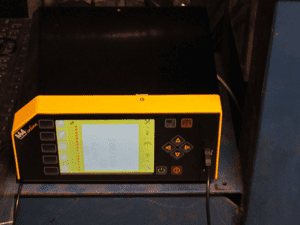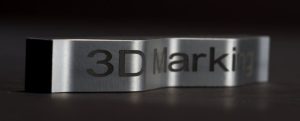Choose for Your Application: The Right Marking System in Industrial Facilities

Part marking systems are crucial across various industries for tracking, identification, quality control, and regulatory compliance. Two popular methods for part marking are dot peen marking and laser marking. Each has its advantages, disadvantages, and typical applications based on factors such as material compatibility, precision, cost, and durability of the mark. Here’s a detailed discussion and comparison:
Dot Peen Marking
Dot peen marking involves a pneumatically or electromechanically driven pin that rapidly indents the material surface with dots to create numbers, letters, logos, or 2D Data Matrix codes. The resulting mark is a series of closely spaced dots forming lines or shapes.
This type of marking is widely used in automotive, metalworking, and aerospace for marking components where the durability of the mark is critical. This can range from the process of adding serial numbers on engine parts to VIN numbers and tool identification.
Dot peen is often preferred for harder materials and where surface deformation is not a concern, whereas laser marking offers broader material compatibility and is better for delicate or heat-sensitive materials.
Advantages of dot peen marking include:
- The marks are deeply embedded into the material, making them highly durable and resistant to wear over time, even in harsh environments.
- Generally less expensive than laser marking systems, both in initial investment and maintenance costs.
- Effective on a wide range of materials, including metals, plastics, and harder materials.
Disadvantages of utilizing dot peen marking include:
- Typically slower than laser marking due to the mechanical process of indenting each dot.
- The mechanical impact may deform delicate parts or surfaces.
- While precise, it may not achieve the fine detail possible with laser systems, especially on very small or complex designs.
Laser Marking
Laser marking uses a high-intensity light beam to slightly alter or ablate the surface material, creating high-contrast marks without contacting the material.
Techniques include engraving, annealing, etching, and foaming, depending on the material and desired effect.
 Laser marking wins in precision and detail, making it preferable for industries requiring intricate designs or small text. It is considered ideal for barcodes, UID codes, QR codes, and detailed logos.
Laser marking wins in precision and detail, making it preferable for industries requiring intricate designs or small text. It is considered ideal for barcodes, UID codes, QR codes, and detailed logos.
Laser marking is commonly used in:
- Electronics
- Medical devices
- Aerospace
- Jewelry
- Applications where precision, minimal part damage, and aesthetic quality of the mark are paramount.
Three main advantages of laser marking are as follows:
- Capable of producing highly detailed, precise marks with excellent resolution. Suitable for small text, complex logos, and even photographic images.
- Can mark a wide range of materials, including metals, plastics, ceramics, and even sensitive materials without damaging them.
- Fast marking process due to the non-contact nature of the laser, which can move quickly over the target surface.
Easily programmable for variable data (e.g., serial numbers), integration into production lines, and minimal maintenance.
Meanwhile, some disadvantages of this marking system include:
- Higher initial investment and operating costs compared to dot peen marking
- Safety precautions necessary due to the use of high-powered lasers
- Certain materials may not mark well or require specific laser types (e.g., fiber, CO2, UV) to achieve the desired contrast or effect.
Note: The size of the parts can also be a factor, as even huge parts can easily be marked with a handheld dot peen marking system, while lasers are not developed to the point they can be utilized for large parts.
Comparing Dot Peen and Laser Marking
Laser marking offers unparalleled precision and flexibility for a wide range of materials and applications, while dot peen marking provides a cost-effective, durable solution for simpler marking tasks.
The choice between dot peen and laser marking ultimately depends on the specific requirements of the application, including:
- The type of material
- The desired mark quality and durability
- Production speed
- Budget constraints
Marking System Choices | Next Steps
Laser marking and dot peen marking are both widely used in industrial applications for the permanent marking of parts and products, but they differ significantly in their mechanisms and outcomes.
Laser marking utilizes a high-intensity light beam to etch or mark the surface of a material, allowing for precise, high-resolution marks including barcodes, QR codes, and intricate graphics, while dot peen marking involves a pneumatically or electromechanically driven pin that physically impacts the surface to create dots forming numbers, letters, or simple logos. Both are useful in any number of industries – depending the needs and expectations of the product line in question.
Investigate the Options, Starting with the Laser Marking System
Our Part Marking page offers a detailed look at the types of lasers and benefits of each, as well as the benefits of dot peen marking as an alternative. The guide also shares info on the type of mark needed and the materials you are marking during production. Take a look:




